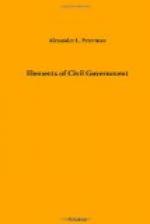ADVANTAGES.—The advantages which have already accrued from the adoption of these laws are manifold:
First, A secret ballot offers an effectual preventive against bribery, since no man will place his money corruptly without satisfying himself that the vote is placed according to agreement.
Second, It secures the voter against the coercion, solicitation, or intimidation of others, and enables him to vote according to the dictates of his conscience.
Third, Bargaining and trading at the polls is prevented, and with these much tumult, riot, and disorder must of necessity disappear.
Fourth, Money is made less of a factor in politics, and the poor man is placed on a plane of equality with the rich as a candidate.
In addition to these obvious advantages, the ballot reform movement promises to have much wider effects, and to pave the way and lay the foundation for other political reforms.
FORMS OF BALLOTS.—On pages 185, 186, and 187 are given forms of ballots and other matter illustrating various methods employed in carrying out the ballot laws of the States. It will be observed that each of these three ballots is representative of a different method.
In the first ballot shown, no party name appears, and the names of candidates for each office are arranged in alphabetical order. On this form of ballot, which most resembles that used in Australia, the individual candidate is made prominent, and party connection does not appear at all.
Second, In the Massachusetts ballot, the names of the candidates are arranged alphabetically under each office, but in addition to this, the party name appears opposite the name of each candidate. On this form of ballot, while the party connection of each candidate is indicated, greater prominence is given to the individual, and the voter is required to make choice of a candidate for each office separately. He cannot vote a straight ticket by a single mark.
Third, In the Indiana ticket, the names are grouped according to party, not according to office, the party name appearing at the head of the ballot as well as at the side of each name. On this form of ballot, the party connection of the candidate is made most prominent, and while provision is made for voting for individuals representing different parties, still the voting of a straight ticket is made most easy.
Many States use the party-column principle of the Indiana ticket, but modify the form of the ticket in various details. The party emblem is sometimes omitted from the circle used in voting a straight picket, or placed just above that circle. The square opposite each candidate’s name is sometimes placed after the name instead of before it; and is usually left blank.




